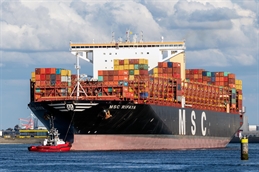
Hapag-Lloyd and Mediterranean Shipping Company are looking to spend billions more per year to be compliant with the new International Maritime Organization’s IMO 2020 rule regulating the sulphur emission of the shipping industry.
Hapag-Lloyd, one of the world’s largest container carriers, said it is expecting to incur up to US$1 billion more annually which involves costs for converting vessels and using the new fuel.
From January 1, 2020, all ships are mandated to use marine fuels with a maximum sulphur content of 0.5%, down from current 3.5% cap to reduce the impact of sulfur emissions released by global shipping.
Hapag-Lloyd CEO Rolf Habben Jansen described 2020 as an “important year.” In particular, he said the IMO 2020 rule is a “milestone” for the shipping industry in its bid to be more environmentally conscious, but he admitted that the new regulation would also prove to be difficult for shipping firms worldwide.
“On the one hand, this marks a milestone for the entire industry on its path to becoming more eco-friendly. On the other hand, the new cap also presents a major challenge to container shipping companies,” Jansen said commenting on the IMO 2020 and the most important issues facing the container shipping industry in the next 12 months.
For Hapag-Lloyd, Jansen said it seeks to transition most of its fleet to use sulphur-compliant fuel instead of retrofit scrubbers.
“Since the lion’s share of our fleet will sail with the new low-sulphur fuel oil, we expect additional costs of around US$1 billion per year,” he said.
He added that aside from IMO 2020, other environmental and climate protection measures will play an “important role” in shipping operations this year like the possibility of the European Union implementing the emissions trading under the “Green Deal” to the shipping industry.
“This means that shipping companies would have to pay for their CO2 emissions in the future. If this should happen, the question will be: which sustainable, alternative fuels can be made available to the industry in order to reduce CO2 emissions, meet regulatory requirements and cut costs? And we live in times that continue to be turbulent in political terms,” the Hapag-Lloyd CEO further said.
Jansen also noted that trade conflicts can have an impact on trade routes, and they can steer global economic growth in one direction.
“We will have to live with these possible fluctuations and manage them as best we can,” he said, adding that Hapag-Lloyd is eyeing to start upgrading its 19,000 TEU ships to 23,000 TEUs between 2022 to 2023.
“We will continue to invest heavily in digital products and services. And we will continue to concentrate on expanding our business in growth regions, such as Africa, the Middle East and India,” Jansen added.
MSC to spend US$2 billion per year
Mediterranean Shipping Company, for its part, said it is strongly committed to the IMO’s enhanced low-sulphur regime and will “work to maximize environmental performance across the MSC fleet in general.”
“We expect to use a very large quantity of compliant low-sulphur fuel and we were also an early mover in ordering UN IMO-approved hybrid exhaust gas cleaning systems for a significant portion of our fleet, in order to enter 2020 with minimal disruption to our networks and services and ensure continued compliant operations,” an MSC spokesperson told Asia Cargo News.
“Our operating costs have been increasing significantly due to the 2020 low-sulphur fuel regime. The cost of the various changes we are making to our fleet and our fuel supply is in excess of US$2 billion per year,” the spokesperson added, noting that it is essential to “segregate the burden of IMO 2020 compliance costs” so it can be passed on throughout the supply chain.
Sought for comment on the implementation, the IMO said there has been “no significant” issue reported following the implementation of the new rule at the start of the year.
“So far, we have not received reports of any significant issues. We are monitoring the situation with regards to implementation and to date, whilst there have been some reports of tight supply of compliant fuel oil in some markets, so far we have not received reports of any significant issues,” Natasha Brown, an IMO spokesperson in London told Asia Cargo News.
“The 0.5% limit is mandatory since January 1, 2020, so compliance with the 0.5% limit has been mandatory since January 1. For non-compliance, the national authorities set in their national laws the penalties for non-compliance and the sanctions,” she added.
Goldman Sachs earlier estimated that the overall impact of full compliance to the IMO 2020 could be as much as US$240 billion – with the cost expected to be passed on to consumers.
Separately, a joint study conducted by the University Maritime Advisory Services (UMAS), found that the United Nation initiative on decarbonization for shipping will cost more than US$1 trillion.
According to a KPMG study “Getting Ready for IMO 2020,” shipping company Maersk expects the new regulatory requirements on sulphur use to bring an additional US$2 billion in costs to the company per year.
Asked about the costs of the IMO implementation, the IMO spokesperson said: “While there are likely to be increased costs as the better quality fuel for ships is likely to cost more, it is important that the costs of pollution from ships are reflected appropriately as increasing the cost of fuel will stimulate innovation and efforts to enhance the energy efficiency of international shipping which, in turn, means less fuel oil is consumed and operational costs are reduced.”
The sulphur limit is one of the tools in IMO’s efforts to ensure a more sustainable and greener shipping industry – and, in particular, cutting greenhouse emissions by 50% in 2050.
The global shipping fleet accounts for 2.2% of the world’s CO2 emissions.
By Charlee C. Delavin
Asia Cargo News | Hong Kong




